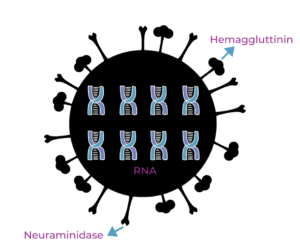
- Flu Facts
Basic Flu Virus Anatomy

What exactly is a virus?
Generally speaking, a virus is a tiny organism that requires a living host cell (e.g., plant, animal, human) to survive and reproduce. It is the reproduction of viruses within these cells that leads to infection that can spread throughout the body. Viruses are different from bacteria, which do not require host cells to survive and reproduce. Bacterial infections are generally treated with antibiotics, whereas viral infections are generally treated with antiviral medications.
What does a flu virus look like?
 Influenza viruses have a specific appearance. The virus is typically a circular shape that contains two different proteins on the outside. The first protein, hemagglutinin (H), is designed to attach the virus to a host cell. After a virus attaches to the host cell, hemagglutinin allows it to enter into the cell. Inside the cell, ribonucleic acid (RNA), which contains the genetic material or “coding” for the virus, creates new copies of the virus. With the help of the second protein, neuraminidase (N), the new viruses are able to leave the cell to go and find more cells to infect. This is how an infection spreads within the body.
Influenza viruses have a specific appearance. The virus is typically a circular shape that contains two different proteins on the outside. The first protein, hemagglutinin (H), is designed to attach the virus to a host cell. After a virus attaches to the host cell, hemagglutinin allows it to enter into the cell. Inside the cell, ribonucleic acid (RNA), which contains the genetic material or “coding” for the virus, creates new copies of the virus. With the help of the second protein, neuraminidase (N), the new viruses are able to leave the cell to go and find more cells to infect. This is how an infection spreads within the body.
How do flu viruses change?
Flu viruses can change when errors occur inside the cell. During the copying process, RNA contains the genetic information to make an exact replication of the virus. Sometimes, there are errors in the replication that create small or large changes in the virus. Flu viruses can change a little (known as antigenic drift) or a significant amount (known as antigenic shift).
Antigenic Drift
Antigenic drift occurs when there is a small change that occurs during RNA replication. These changes can result in slight differences in the surface proteins, hemagglutinin and/or neuraminidase, that may then affect the ability of your body’s immune system to recognize and attack the new flu virus. This changing of influenza viruses is common and explains why people can get the flu more than once (e.g., each season or even multiple times during the same season). This is also why it’s important to get an annual flu vaccination each and every year to ensure your body has immunity to the new flu strains that may be circulating.
Antigenic Shift
Antigenic shift occurs when there is an abrupt, major change that occurs in flu viruses, resulting in a new combination of surface proteins (hemagluttinin and neuraminidase). This can happen when influenza viruses from animals (e.g., ducks, birds, pigs) combine with influenza viruses from humans to form a new influenza virus, against which humans have little to no immunity. If this new flu virus can spread easily from person-to-person, it has the ability to result in a pandemic. Fortunately, flu pandemics are rare. In the last 100 years, there have been four flu pandemics, including the 1918-1919 Spanish flu (H1N1), the 1957-1958 Asian flu (H2N2), the 1968 pandemic (H3N2), and the 2009 pandemic (H1N1).
Sources:
https://www.cdc.gov/flu/about/viruses/change.htm
https://www.cdc.gov/flu/pandemic-resources/basics/past-pandemics.html


